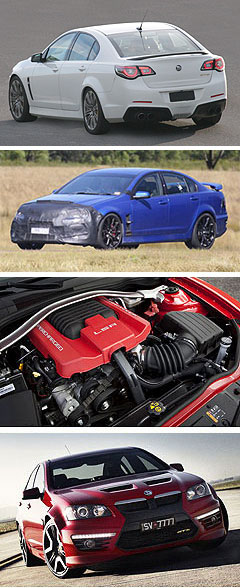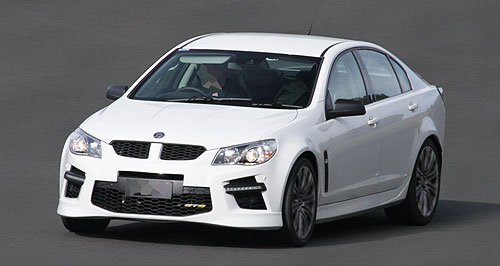News - HSV - Gen-F - GTSHSV Gen-F sprung undisguisedNose job: Ramming as much air as possible into the engine bay of HSV’s supercharged new GTS is an array of big intakes on the front bumper. Spy shots reveal HSV Gen-F GTS ahead of official May 15 unveiling7 May 2013 AUSTRALIA’S most powerful homegrown production car in history – HSV’s supercharged Gen-F GTS – has been sprung undisguised in these spy shots ahead of its official unveiling on May 15. The news comes as GoAuto sources indicate that Holden is preparing to announce a sub-$35,000 starting price for its crucial new VF Commodore later this week. Ensuring an adequate supply of air for cooling and combustion in the monstrous 430kW/740Nm 6.2-litre supercharged LSA engine under the bonnet of the GTS is a letterbox-like vent above the numberplate and a gaping lower air intake. The size and position of the letterbox intake is consistent with openings in the camouflage of an HSV prototype spotted by GoAuto last October, which all but confirmed the Holden hot-shop was working on a supercharged model as it emitted the whine of a supercharger under acceleration. Further fresh air is supplied by side intakes, across which are LED daytime running light strips but no front foglights to get in the way of the breeze. Of course, there is HSV’s trademark nostril-style grille between the standard VF Commodore headlights, completing an aggressive front-end look that perfectly complements the angry ‘furrowed brow’ of the VF’s sculpted aluminium bonnet. Presumably the cost of adding vents to the new aluminium bonnet – as per the outgoing E-Series 3 vehicles – was too high, or they did not look right due to the curvaceous new design. On the subject of vents, the VF’s non-functional ‘gills’ behind the front wheels are carried over to HSV models – again probably due to the cost of creating custom aluminium guards – but with a gloss-black finish rather than chrome. Around the back things are understood to be tamer than HSV originally planned, as sources suggest the slimline black rear wing seen here was chosen due to downforce from the intended large wing causing the VF’s aluminium bootlid to flex at high speed. This time around, HSV sedans will share the shape and positioning of standard VF tail-lights – but with a fancier LED design and black outer trim – while the E-Series 3’s big trapezoidal tailpipes have been replaced with large-bore quad outlets, nestled in black diffuser-like bumper inserts. It all adds up to a more conservative design than the E-Series 3, with less differentiation from a standard V8 Commodore – even the wheels on the car in these spy shots look similar to those on a VF Calais V. The black mirrors, rear wing, side gills, tail-light trim and daytime running light surrounds provide contrast with the white bodywork of the car pictured and could form part of an optional ‘black pack’.  From top: Spied GTS, Supercharged HSV prototype, LSA powerplant and E-series 3 GTS. From top: Spied GTS, Supercharged HSV prototype, LSA powerplant and E-series 3 GTS.Inside, the typical HSV dash-top dial pack has been deleted, probably due to the difficulty of integrating with the sleeker moulded dash-top. GoAuto understands similar functionality has been replicated via an update to HSV’s groundbreaking Enhanced Driver Interface (EDI), accessed via the in-dash touchscreen – and possibly even the head-up display where fitted. Debuting in the E-Series 3, the EDI system provided telemetry functions such as lap times and G-forces achieved during cornering, braking and acceleration. Despite the range-topping GTS being expected to nudge $100,000 when it hits showrooms in August, visual differences between compared with less potent naturally aspirated stablemates are understood to be surprisingly subtle. All models ride on 20-inch alloys, with HSV parting company from long-time tyre supplier Bridgestone in favour of Continental rubber. The GTS gets high-performance six-piston callipers, while naturally aspirated variants remain on four-piston units. Also unique to the GTS is a supercar-style electronically controlled torque vectoring rear differential, which can accurately control the amount of drive sent to each wheel to maintain optimum traction. The entry-level ClubSport, which will carry over the naturally aspirated 317kW/550Nm 6.2-litre LS3 V8, looks similar to the GTS but with front foglights replacing the flagship’s outboard bumper intakes. R8 versions of the ClubSport sedan, Tourer wagon and Maloo ute will continue, with a 325kW/550Nm version of the naturally aspirated V8, while the luxury Senator Signature and Grange limo will be further pumped up to 340kW/570Nm. This power and torque hike will also be available on the R8 through an SV Enhanced option pack comprising a special air intake system and cosmetic enhancements. With the Chevrolet Camaro ZL1’s mighty engine under the bonnet, the Gen-F GTS is expected to achieve the 0-100km/h sprint in less than 4.5 seconds. Weight savings achieved for the VF Commodore should translate to improved acceleration times for the rest of the HSV Gen-F range.  Read more27th of April 2013  HSV expected to supercharge Gen-F GTSSupercharged Gen-F HSV GTS shapes up as most potent Aussie road car ever9th of October 2012  HSV testing supercharged V84.0-second HSV on the cards as Camaro’s hot LSA V8 looms large for 2014 'F Series' |
Click to shareHSV articlesResearch HSV Motor industry news |















Facebook Twitter Instagram